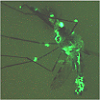Rarely do the worlds of nanotech and carnival cuisine overlap, but when they do the results can be pretty sweet. A team of engineers has created a technology for fabricating nanofibres that’s half high-speed centrifuge, half fairy floss machine, spinning and stretching out ultra-thin nanofibres that measure just 100 nanometres in diameter.
Like most technologies prefixed with “nano,” this one has a wide range of applications in fields ranging from textiles to air filters to biotech. Moreover, it could drastically reduce the cost and complexity of nanofibres manufacture, making the tiny threads a cost effective option in countless products.
To produce nanofibres, manufacturers generally employ a technique called electrospinning, which involves shooting a high-voltage charge through a polymer liquid to extract long nanothreads. The threads themselves are fine, but the process offers little control and isn’t really scalable to mass manufacture, not to mention it’s a bit energy-intensive.
The new method opts for rotary jet spinning, which closely resembles the method used in fairy floss machines to draw out long wispy threads from molten sugar. The machine rapidly feeds a polymer material into a rotating drum then spins the material out into long, thin fibers through an extrusion needle. Fibers can be easily engineered to be thicker or thinner, have varying textures, or be spun directly into molds that shape them into 3-D structures. The result is more control, higher yields, and a far simpler overall process compared with electrospinning.
The team has already tested the device on a handful of synthetic and natural polymers, including the eco-friendly polylactic acid, otherwise knows as that biodegradable plastic that comes from corn starch. They even used it to form tissue scaffolds that allow biological matter to grow in controlled ways. By integrating heart tissue from rats into the nanofibres, they were able to grow beating muscle tissue in the lab. And all that’s just for starters. Unlike fairy floss, this nanofibre tech should get better with time.
Popular Science has been a leading source of science, technology and gadget news since 1872. With up-to-the minute latest space news, insightful commentary on the new innovations and concept cars ...if it's new or future technology you'll find it at popsci.com.au.
WW Media - Popular Science © 2010
Gadgets - Cars - Science - SEO






